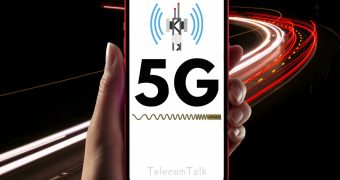
Samsung has partnered with KT and KDDI Research to explore AI integration in 6G networks, while e& UAE, Nokia, and Qualcomm have demonstrated 1024 QAM technology for 5G standalone networks. Additionally, Verizon has expanded its satellite texting services, ensuring seamless connectivity beyond terrestrial networks. Read on to discover how these innovations are shaping the future of wireless communication.
Also Read: Ericsson: SoftBank Partnership for AI, 6G; Drei Austria Tests W-Band, Tunisie Telecom 5G and More
1. Samsung and KT Partner to Advance 6G, E& UAE Demonstrate 1024 QAM and More
Samsung Electronics and KT Corporation (KT), South Korea's major telecommunications company, signed a memorandum of understanding (MOU) in March to jointly research and develop communication technologies aimed at improving 6G signal quality. As part of this collaboration, the two companies will advance multi-antenna technologies to expand coverage across potential 6G frequency bands and explore AI integration in wireless communication to improve network stability and performance, Samsung said in a joint announcement on March 31.
Samsung and KT have begun research into eXtreme multiple-input multiple-output1 (X-MIMO) — an ultra-high-density antenna technology designed to enhance 6G coverage and increase data transmission speeds, according to the official release,
The World Radiocommunication Conference 2023 (WRC-23), hosted by the International Telecommunication Union (ITU), identified the 7 GHz band (7.125–8.4 GHz) as a candidate frequency for 6G. The global mobile communications industry considers this band as a key option due to its favourable frequency characteristics and spectrum availability. However, because the 7 GHz band operates at a higher frequency than the 3.5 GHz C-band used in 5G, it experiences greater signal path loss. Mitigating this loss is critical to achieving communication coverage comparable to that of 5G, the companies explained.
To address this challenge, Samsung and KT will research beamforming technology, which transmits focused signals in specific directions, and multi-spatial transmission technology, which uses multiple beams to deliver data to several users simultaneously. In X-MIMO systems operating in the 7 GHz band, more antennas will be used compared to 5G — requiring system architectures capable of efficiently managing ultra-high-density antennas.
Convergence of AI and Telecom
Additionally, both companies plan to explore the convergence of telecommunications and AI to deliver an improved user experience, particularly in edge coverage areas. The companies cited an example saying that AI can be used to predict and proactively respond to potential communication disruptions such as video streaming interruptions.
"We are committed to developing innovative 6G technologies that enhance both the operational efficiency of the 7GHz band and the overall user experience," said Angelo Jeongho Park, Executive Vice President and Head of Advanced Communications Research Center (ACRC), Samsung Research at Samsung Electronics. "Our collaboration with KT will serve as a key foundation for advancing next-generation communications through reasonable, cost-effective investments."
"Through this joint research with Samsung Electronics, we expect to secure next-generation network technologies that differentiate the quality of the user experience," said, Jong-Sik Lee, Executive Vice President and Head of Future Network Laboratory at KT. "We will further strengthen our efforts in developing core 6G technologies to lead future mobile communication innovations."
What is MIMO Technology?
Multiple-input multiple-output (MIMO) technology improves communication performance by utilising multiple antennas at both the transmitter and receiver.
2. Samsung and KDDI to Research AI in 6G Distributed MIMO
Samsung Electronics and KDDI Research, the R&D institute of Japanese telecommunications service provider KDDI, signed an MOU in February for joint research into the application of AI in next-generation mobile communication networks. As 6G standardisation gains momentum with AI technology expanding across industries, the two companies aim to enhance overall network performance by applying AI to multiple-input multiple-output (MIMO) technologies. MIMO systems increase transmission speed and expand coverage by utilising multiple antennas to transmit and receive signals.
In contrast to traditional MIMO systems that transfer data in a single-cell network, distributed MIMO (D-MIMO) systems deploy multiple cells to offer advantages such as improved performance in coverage boundary areas and the network overall.
Through this collaboration, Samsung and KDDI Research will research AI-driven solutions to optimise the design and operation of D-MIMO systems — enabling higher transmission speeds at the user level and increased network-wide capacity.
"The joint research with KDDI Research will play an integral role in innovating wireless telecommunications through the convergence of telecommunications and AI technologies," said Paul (Kyungwhoon) Cheun, CTO of Device eXperience (DX) Division at Samsung Electronics and Head of Samsung Research, in a statement on March 6.
"I anticipate that our research collaboration will highlight the critical role of AI and D-MIMO in developing a user-centric network that delivers exceptional wireless quality across the target area, ultimately creating new value in 6G," said Hajime Nakamura, President and CEO of KDDI Research.
Beyond these partnerships and updates, Samsung stated that it released a 6G white paper titled AI-Native and Sustainable Communication, in February, outlining its vision for AI-native and sustainable communication technologies.
Also Read: Nokia, Nvidia, and Telcos Collaborate to Accelerate AI-RAN Development: MWC25
3. E& UAE, Nokia, and Qualcomm Demonstrate 1024 QAM Technology on 5G SA
UAE's E&, Nokia and Qualcomm Technologies have demonstrated 1024 Quadrature Amplitude Modulation (QAM) technology in e& UAE's 5G standalone (SA) network. This modulation technology enhances network efficiency and performance, delivering superior user experience for both business and consumer customers, the companies said in a joint announcement on March 9, 2025.
Nokia stated that the adoption of 1024 QAM enables a 25 percent increase in spectral efficiency compared to traditional 256 QAM, paving the way for Advanced 5G. Utilising a higher-order modulation scheme allows for more data transmission within the same spectrum, resulting in faster speeds, reduced latency, and improved capacity for modern digital lifestyle and enterprise applications.
The trial was conducted using Nokia's AirScale Massive MIMO radios and baseband solutions including 5G Carrier Aggregation software, and a device powered by a Snapdragon 8 Elite Mobile Platform from Qualcomm Technologies. The aggregation of e& UAE's three carriers in 3.5 GHz and 2.6 GHz frequency bands for a total bandwidth of 290 MHz, combined with 1024 QAM modulation, delivered a total throughput of 6.2 Gbps.
Mark Atkinson, Senior Vice President and Head of Radio Access Networks at Nokia, said: "As 5G networks evolve, these advanced technologies enable premium performance and enhanced efficiencies to support new enterprise and consumer services and deliver superior user experiences."
Abdulrahman Al Humaidan, Vice President of Fixed Access Network, e& UAE, said: "Trialing 1024 QAM in our 5G network aligns with our vision to provide the most advanced and reliable connectivity to our customers."
Wassim Chourbaji, SVP and President of Qualcomm MEA and SVP of Government Affairs EMEA, Qualcomm France S.A.R.L. said, "With the Snapdragon 8 Elite Mobile Platform, we are setting a new standard in connectivity performance and unlocking enhanced experiences for consumers in the region."
Also Read: Verizon Infuses AI into Network, Achieves New 5G Upload Speed, Adds IoT Partners
4. Verizon Expands Satellite Texting Services
Verizon announced on March 19, 2025, a significant expansion of its satellite texting capabilities, enabling its customers to become the first in the US to send text messages to any other customer device via satellite when outside the reach of terrestrial cellular networks. The service will be available to customers using select Android devices from the series of Samsung Galaxy S25 and Google Pixel 9 smartphones. Upgrades enabling this service have started and will continue over the next two weeks, Verizon said.
"Verizon's network is America’s largest and already covers 99 percent of the places where people live, work and play. This expansion of satellite texting capabilities is a testament to our commitment to ensure customers stay connected wherever they are," said Joe Russo, EVP and President of Global Network and Technology.
Verizon says it continues to push the boundaries of satellite and terrestrial telecommunications convergence. "Satellites are no longer reserved for the extraordinary—they are woven into the everyday, and are being used to help connect and power customers' lives," the company said, adding that Verizon's approach to satellite integration extends beyond basic satellite-to-cellular messaging.
This announcement follows Verizon's recent work testing data services and video calling via satellite connectivity using AST SpaceMobile Bluebird 2. The company said it also utilises satellite technology for various purposes, including providing service in emergency situations through satellite-linked portable assets, using satellite connections as temporary backhaul for new cell sites, and providing satellite IoT capabilities for various industries.















